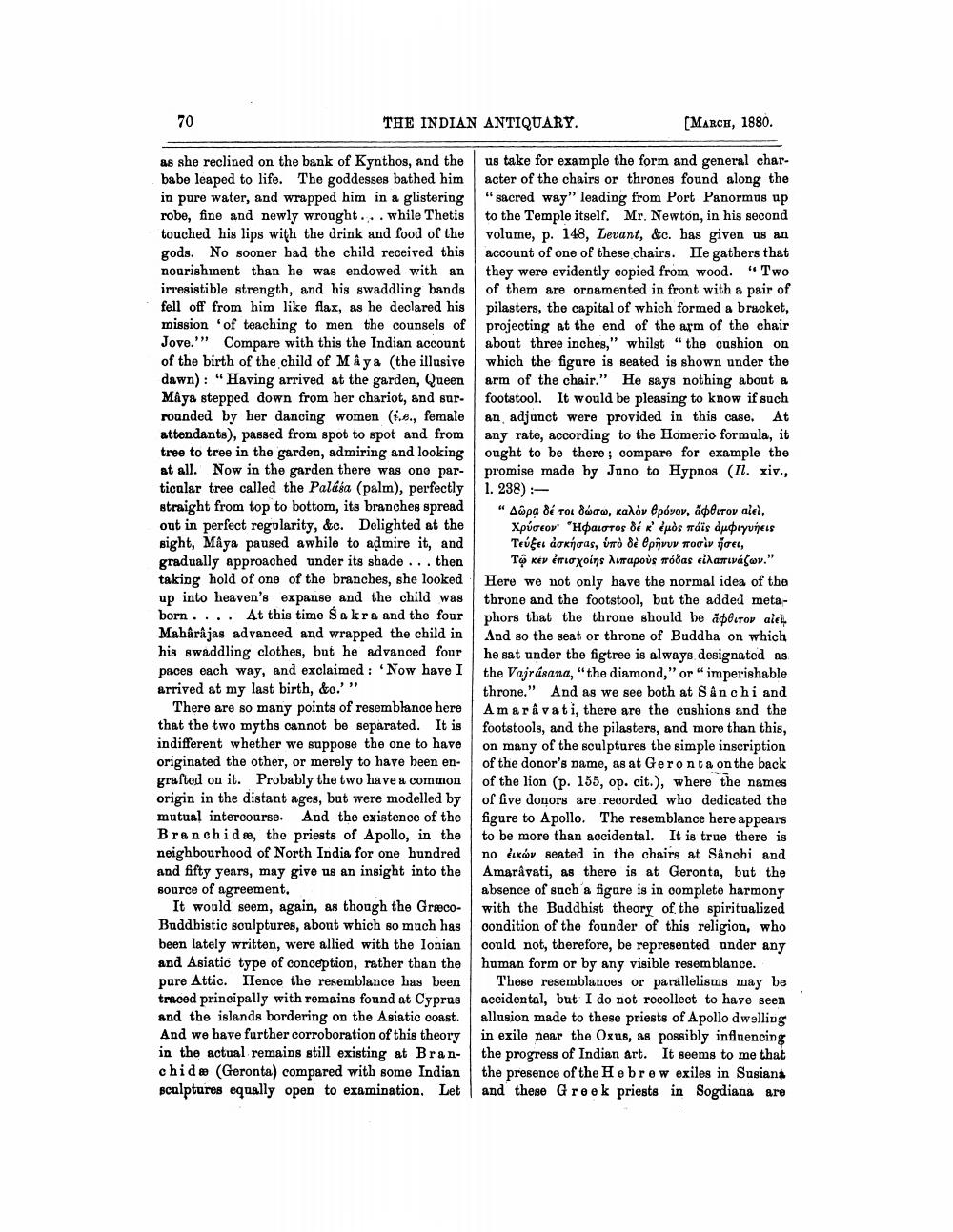________________
70
THE INDIAN ANTIQUARY.
as she reclined on the bank of Kynthos, and the babe leaped to life. The goddesses bathed him in pure water, and wrapped him in a glistering robe, fine and newly wrought... while Thetis touched his lips with the drink and food of the gods. No sooner had the child received this nourishment than he was endowed with an irresistible strength, and his swaddling bands fell off from him like flax, as he declared his mission of teaching to men the counsels of Jove."" Compare with this the Indian account of the birth of the child of Mâya (the illusive dawn): "Having arrived at the garden, Queen Mâya stepped down from her chariot, and surrounded by her dancing women (ie., female attendants), passed from spot to spot and from tree to tree in the garden, admiring and looking at all. Now in the garden there was one particular tree called the Palása (palm), perfectly straight from top to bottom, its branches spread out in perfect regularity, &c. Delighted at the sight, Mâya paused awhile to admire it, and gradually approached under its shade... then taking hold of one of the branches, she looked up into heaven's expanse and the child was born. ... At this time Sakra and the four Mahârâjas advanced and wrapped the child in his swaddling clothes, but he advanced four paces each way, and exclaimed: 'Now have I arrived at my last birth, &c.'"
There are so many points of resemblance here that the two myths cannot be separated. It is indifferent whether we suppose the one to have originated the other, or merely to have been engrafted on it. Probably the two have a common origin in the distant ages, but were modelled by mutual intercourse. And the existence of the Branchide, the priests of Apollo, in the neighbourhood of North India for one hundred and fifty years, may give us an insight into the source of agreement.
It would seem, again, as though the GræcoBuddhistic sculptures, about which so much has been lately written, were allied with the Ionian and Asiatic type of conception, rather than the pure Attic. Hence the resemblance has been traced principally with remains found at Cyprus and the islands bordering on the Asiatic coast. And we have further corroboration of this theory in the actual remains still existing at Branchide (Geronta) compared with some Indian sculptures equally open to examination. Let
[MARCH, 1880.
us take for example the form and general character of the chairs or thrones found along the "sacred way" leading from Port Panormus up to the Temple itself. Mr. Newton, in his second volume, p. 148, Levant, &c. has given us an account of one of these chairs. He gathers that they were evidently copied from wood. "Two of them are ornamented in front with a pair of pilasters, the capital of which formed a bracket, projecting at the end of the arm of the chair about three inches," whilst "the cushion on which the figure is seated is shown under the arm of the chair." He says nothing about a footstool. It would be pleasing to know if such an adjunct were provided in this case. At any rate, according to the Homeric formula, it ought to be there; compare for example the promise made by Juno to Hypnos (Il. xiv., 1. 238):
"
' Δῶρᾳ δέ τοι δώσω, καλὸν θρόνον, ἄφθιτον αἰεὶ, Χρύσεον· Ηφαιστος δέ κ' ἐμὸς πάϊς ἀμφιγυήεις Τεύξει ἀσκήσας, ὑπὸ δὲ θρῆνυν ποσὶν ἥσει, Τῷ κεν ἐπισχοίης λιπαροὺς πόδας εἰλαπινάζων.” Here we not only have the normal idea of the throne and the footstool, but the added metaphors that the throne should he ἔφθιτον αἰεὶς And so the seat or throne of Buddha on which
he sat under the figtree is always designated as the Vajrasana, "the diamond," or "imperishable throne." And as we see both at Sân chi and Amaravati, there are the cushions and the footstools, and the pilasters, and more than this, on many of the sculptures the simple inscription of the donor's name, as at Geronta on the back of the lion (p. 155, op. cit.), where the names of five donors are recorded who dedicated the figure to Apollo. The resemblance here appears to be more than accidental. It is true there is no ékáv seated in the chairs at Sânchi and Amaravati, as there is at Geronta, but the absence of such a figure is in complete harmony with the Buddhist theory of the spiritualized condition of the founder of this religion, who could not, therefore, be represented under any human form or by any visible resemblance.
These resemblances or parallelisms may be accidental, but I do not recollect to have seen allusion made to these priests of Apollo dwelling in exile near the Oxus, as possibly influencing the progress of Indian art. It seems to me that the presence of the Hebrew exiles in Susiana and these Greek priests in Sogdiana are




